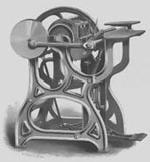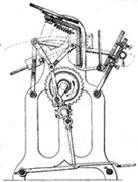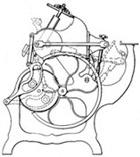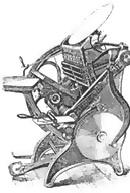|
JOSIAH WADE LTD. (UK)
Arab Platen, 1872 »
Also referred to at times as the Anglo-American Arab. The Arab platen was patented in 1872 by Yorkshireman, Josiah Wade and was based on George Gordon's Franklin Press. Some notable improvements were added, including leather bearer [track] straps, which could be easily adjusted for roller height. The Halifax plant closed in 1959, some 40,000 machines having been produced there. The business was bought by Wellsman and Parry, of Liverpool, U.K. and continued trading into the 1960's.
GEORGE P. GORDON (USA)
Patent No. 148,050; 1873 »
This Franklin New Style had in addition to the normal rotating ink disk another mounted directly above it. After impression the inkers rolled up and re-charged with ink from the lower disk. Upon the inkers reaching the ink duct, both disks were lowered enabling them to receive a further distribution from the upper disk. Roller bearers (somehow?) kept pressure on this upside down disk. Production details unknown, probably never manufactured.
ALLAN MANUFACTURING CO. (USA)
The National Jobber, 1874 »
Compact 'flattened cylinder' clamshell type with hinged platen attached to crank driven drawbars. Inkers circulated continuously around the stationary cylinder, which acted as a large distributing drum, and over the forme. Size of platen 7" x 11".
F. W. GRIFFITH & G. P. BYRNE (USA)
Patent No. 168,635; 1875
Another 'flattened cylinder' clam-shell press. Printed sheets were delivered automatically via tapes to a delivery table beneath the press.
GEORGE. P. APPLETON (USA)
Patent No. 196,512; 1877 »
Type-bed and platen connected via a swinging frame, the rods and platen at points approximately the same distance from their respective centres of motion and the toggle-lever jointed to the swinging frame on the same axis with the connecting rods, being combined and arranged for joint operation.
EDWARD DUMMER (USA)
Patent No. 197,021; 1878 »
Small, compact treadle-powered press claimed to have the least number of moving parts of any treadle-powered clamshell platen, due to continuous one-way rotation of the three inkers - there being no reciprocating move-ment to rollers or ink disk, which worked directly from the crankshaft. This in turn ensured less energy to power it.
CURTIS & MITCHELL (USA)
Patent No. 207,499 1878 »
The Columbian Job Press had a rigid bed with an oscillating platen which was supported on legs hinged near the base and front of the frame. Slotted draw bars, driven via cranks drew the platen through the impression cycle only but a cam-operated shaft which connected to the extension of the platen legs controlled the remaining motion. This enabled the platen to stay open (on 'dwell') a little longer, thereby assisting the feeder.
JOHN M. JONES (USA)
Patent No. 215,459; 1879 »
Jones developed many successful platen jobbers including the Star, Washington, Jones-Gordon, Clipper and Jewel, as well as the patents to cover them. Jones had patented a "domestic printing machine," or typewriter (Pat. 14,919; 1856), and his hand stamp before he became involved with platen jobbers.
WILLIAM HUGHSON GOLDING (USA)
Golding Jobber, 1879 »
Golding began manufacturing platen presses in Boston during the 1870's. His Golding Jobber, a treadle-powered clamshell, was claimed to be very well balanced and required minimum effort to treadle it. The platen, hinged at its base, oscillated to a fixed bed by means of a clever knee-action toggle which allowed a considerable dwell when the platen was open. The Art Jobber included an oscillating curved ink plate beneath the platen for superior ink distribution.
|
|















